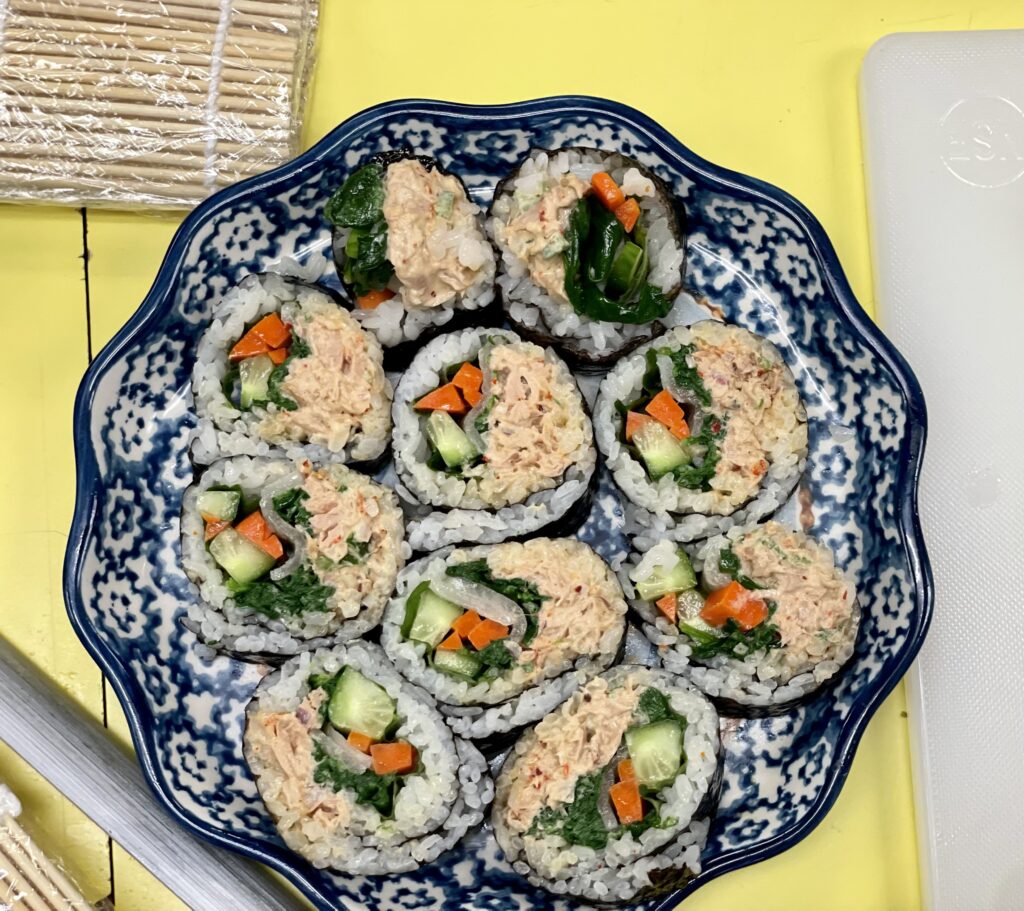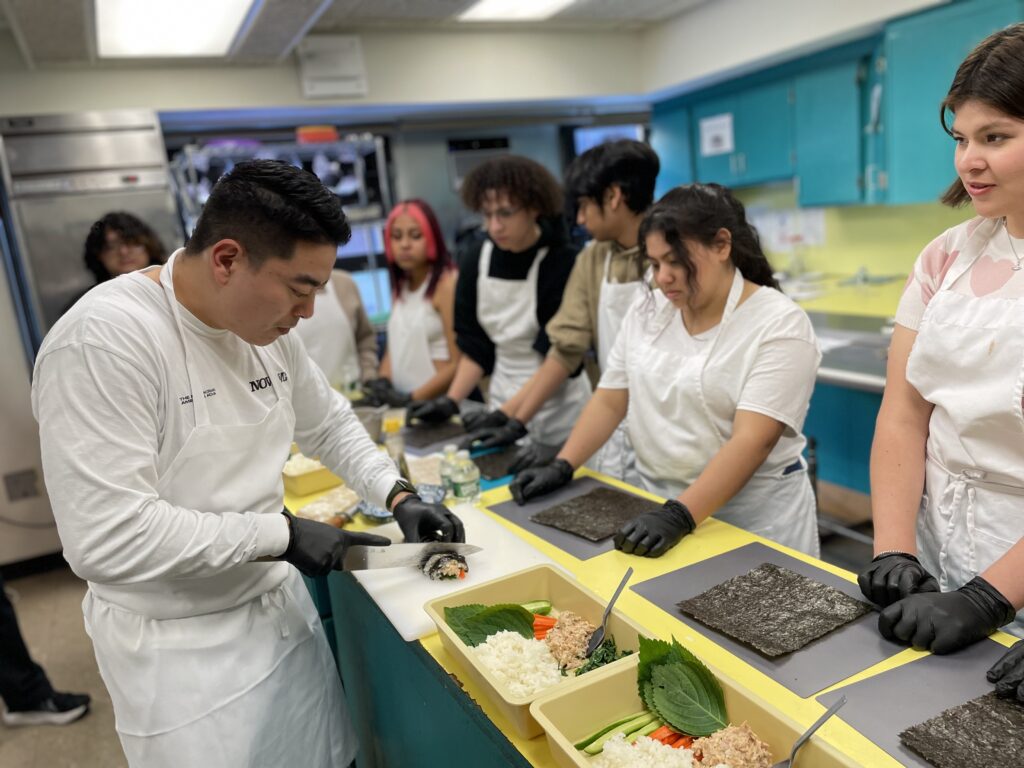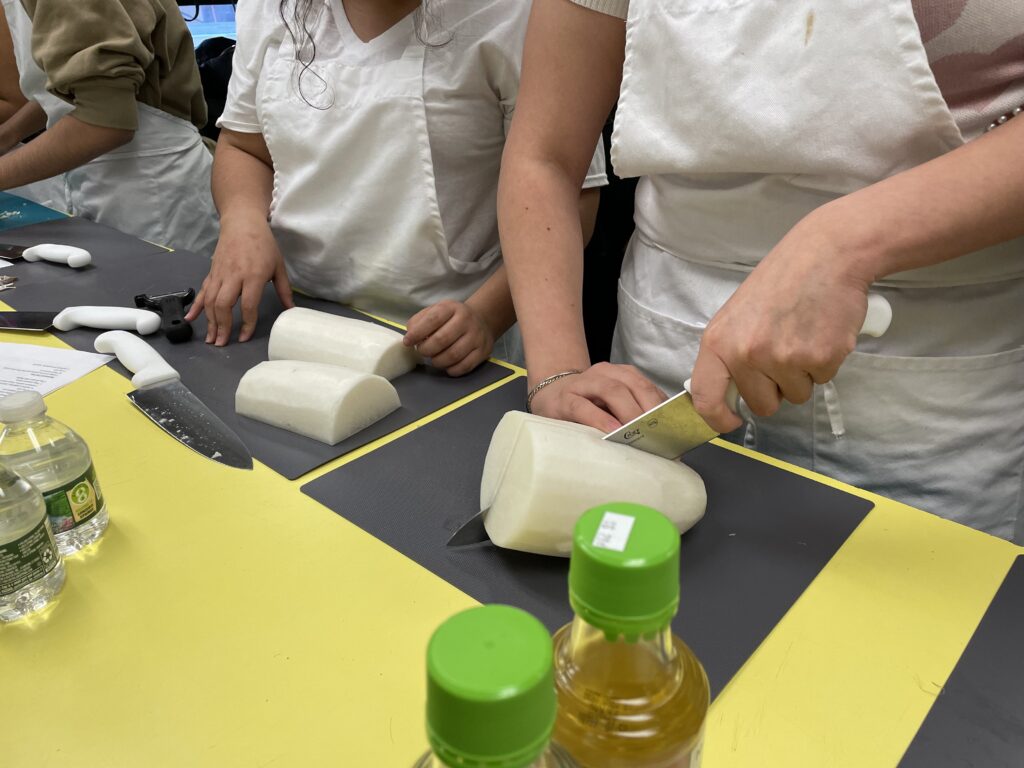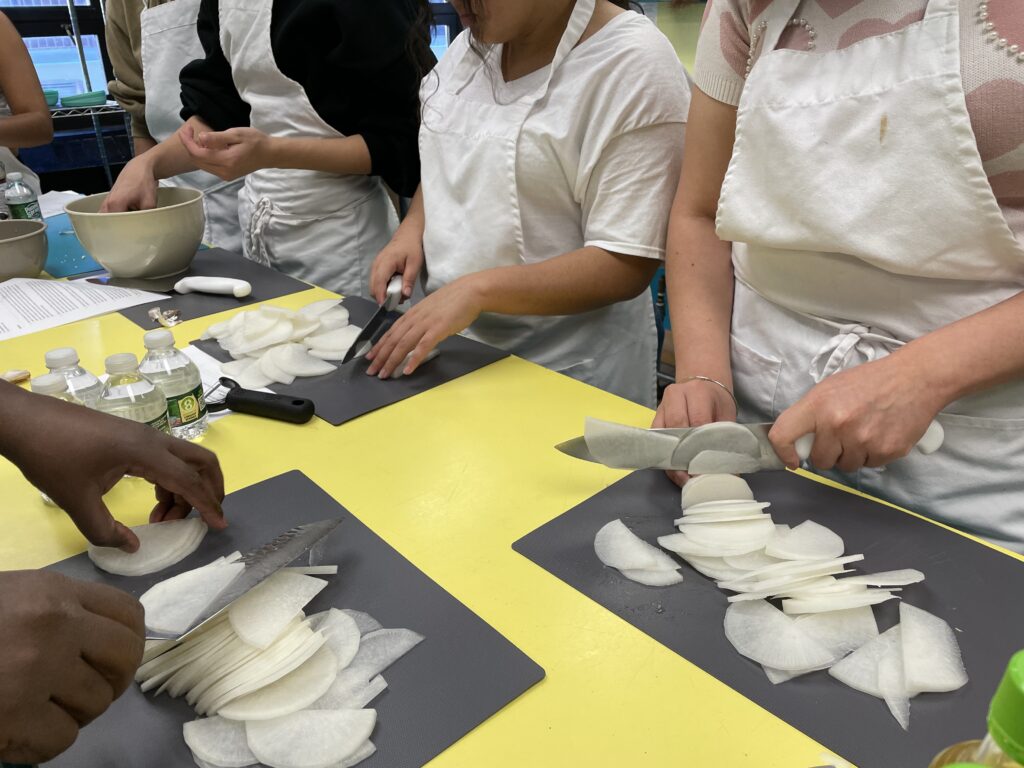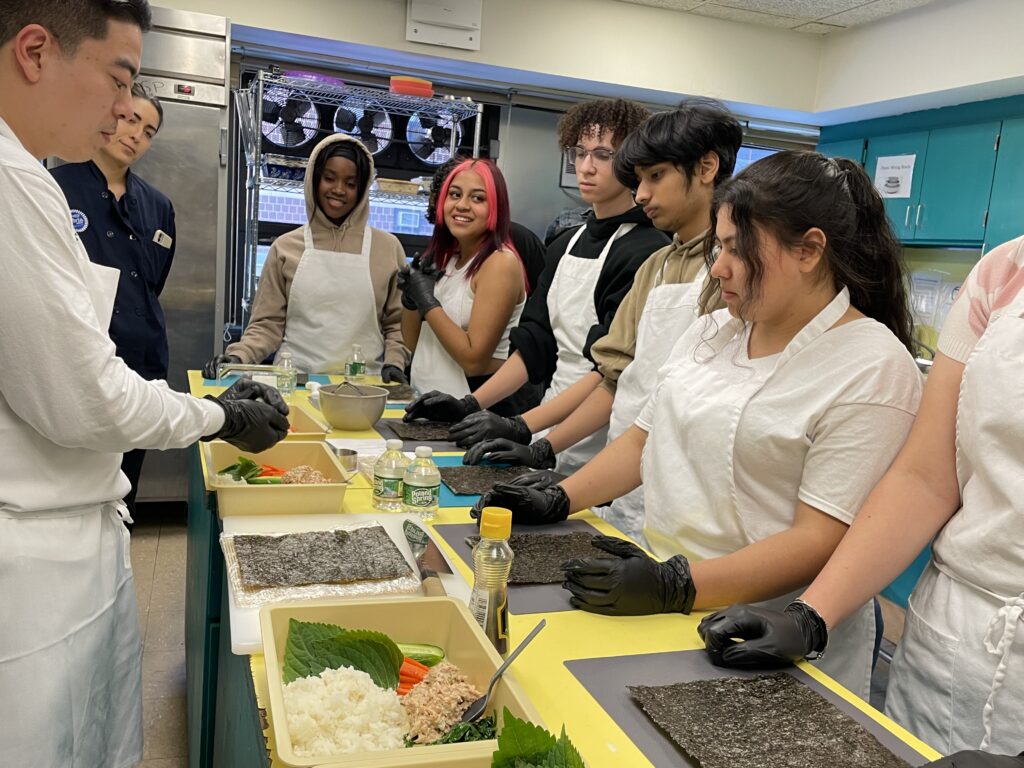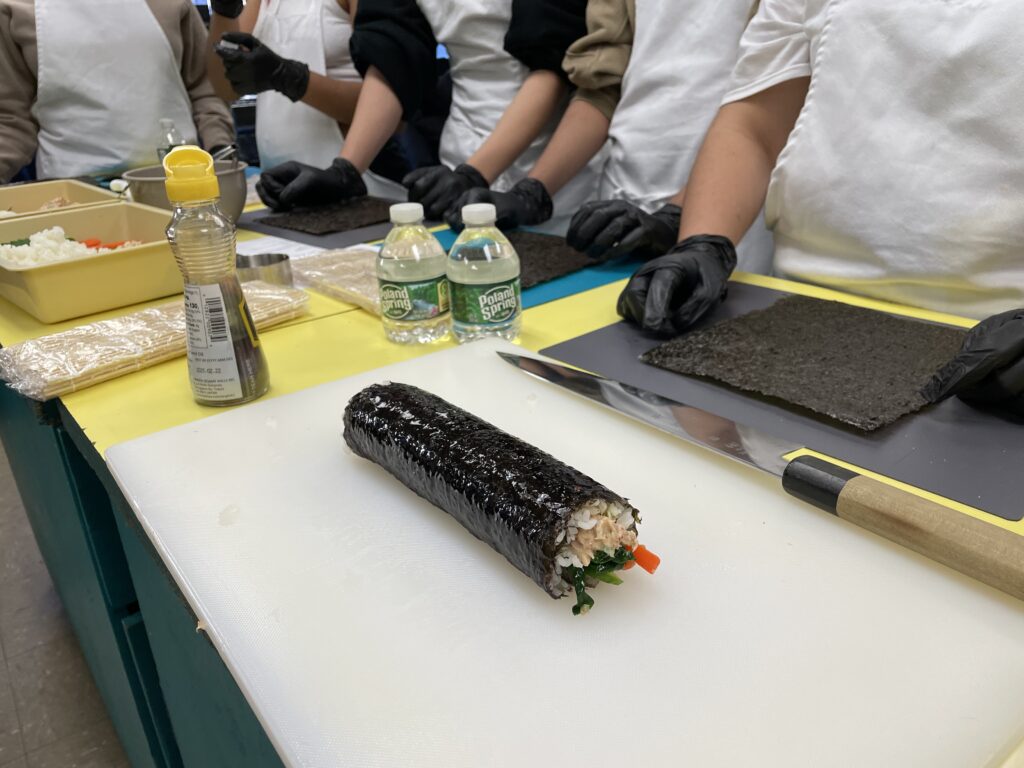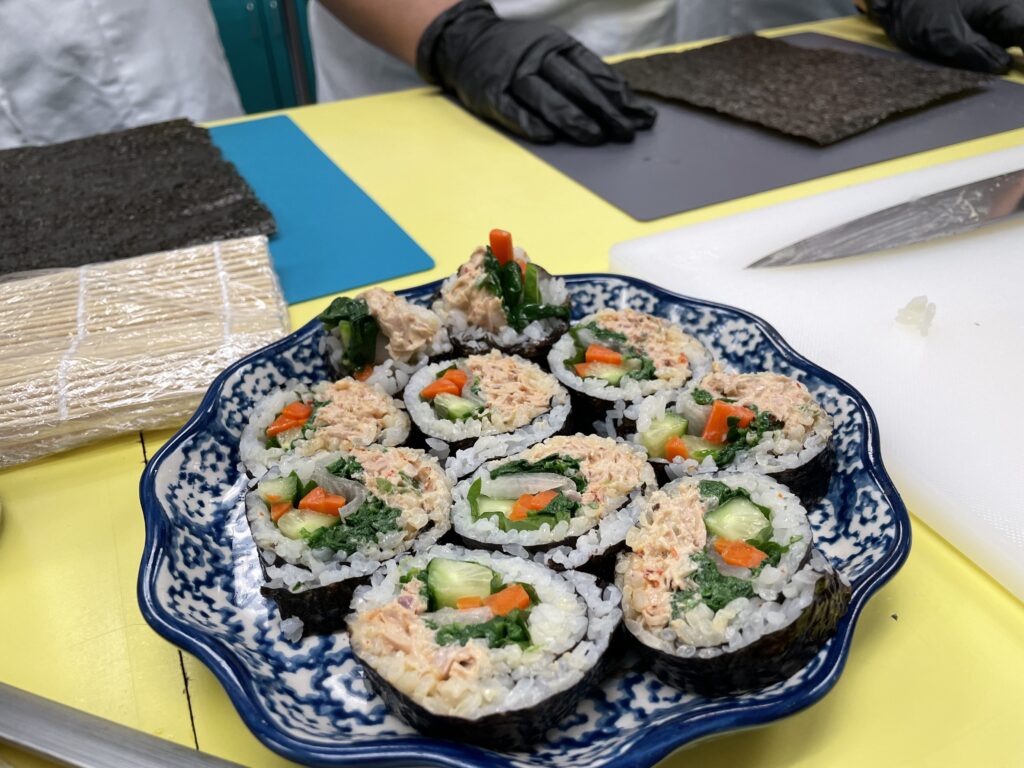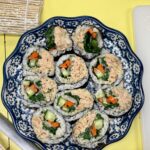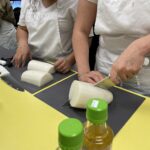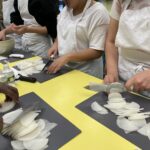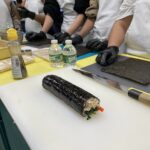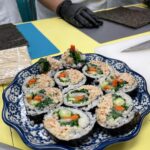Chef Jae Lee, a member of TSC’s Culinary Council and founder of Nowon, taught a Sylvia Center class where he demonstrated his family’s Kimbap recipe to Work Based Learning apprentices at Lower East Side Prep. Kimbap, a favorite snack from his childhood, is a Korean seaweed rice roll packed with a variety of fillings such as pickled daikon radish, seasoned carrots, and garlicky spinach. Chef Lee fondly remembers snacking on kimbap with his brother while their mother prepared dinner. This vegetable-packed recipe delivers a real flavor punch and allows our students to explore Korean ingredients, flavors, and cooking techniques.
Let us know if you try this special recipe at home + tag us @sylviacenter.
Prep Time: 1 hour | Serves: 10 people / 3-4 large rolls or around 30-40 pcs
Ingredients
Large nori sheets (high quality)
1 Persian cucumber, cut into small spears
4-5 perilla leaves, tough stems removed
½ jalapeno, seeded and sliced finely
Kimbap Rice
1 C sushi rice
1 ¼ C water
1 tsp sesame oil
1 tsp salt
Pickled Daikon
½ medium daikon radish, sliced into thin rounds (approx. 100g final yield)
1 tsp salt
1 C rice wine vinegar
1 C sugar
Tuna Salad
2 x 5-oz cans tuna, drained
¾ C Japanese mayonnaise
1 Tbsp Dijon mustard
1 Tbsp sesame oil
½ tsp salt
½ medium jalapeno, minced jalapeno (1 Tbsp final yield)
1 medium shallot, finely diced (3 Tbsp final yield)
1 Tbsp sesame seeds
2 tsp Korean chili flakes
Seasoned Carrots
2 large carrots, peeled and cut into thin strips
¾ Tbsp canola oil
⅓ tsp salt
1 medium clove garlic, minced
Seasoned Spinach
1 x 16-oz bag fresh spinach, blanched and squeezed (approx. 120g/4oz final yield)
¾ Tbsp sesame oil
⅛ tsp salt
½ clove garlic, minced
½ tsp sesame seeds
Method
- Start by making the rice. Put the rice in a pot, then rinse and drain it under cold running water 4–6 times, until the water runs clear. Add the rice back to the pot along with 1 ¼ C water. Bring to a boil. Reduce the heat to low, and cover the pot with a lid or plate. Cook on low for 15 minutes, turn off the heat and allow to rest, covered, for a further 5–10 minutes. Carefully remove the lid, being wary of the steam, and fluff with a wooden spatula or rice paddle. Season with the salt and sesame oil and gently mix, taking care not to damage the grains. Set aside until needed.
- While the rice is cooking, make the pickled daikon. Thinly slice the daikon radish using a very sharp knife or a mandolin. Add the slices to a bowl, and scatter the salt across the top. Allow to rest for 10 minutes. While the daikon is resting, add the rice vinegar and sugar to a pot and, over a medium-high heat, bring to a boil. Once boiled, remove from the heat and allow to cool to room temperature. Wash the salt from the rested daikon slices and strain well. Add to a medium bowl. Pour the vinegar mix over the daikon and let sit until needed.
- Make the tuna salad. In a medium bowl, mix together all the ingredients until well combined. Store, covered, in the refrigerator until needed.
- Make the seasoned carrots. In a medium pan over a medium-low heat, add the oil, carrots, garlic and salt. Gently sauté for 3–4 minutes until just cooked, with a slight bite. Be careful to keep the heat low: you want to cook, but not color, the carrots. Add the sesame oil just before removing from the heat. Tip into a bowl or plate and set aside to cool until needed.
- Make the seasoned spinach. To a medium bowl, add a handful of ice cubes and 2 C cold water. In a medium pot, bring 2 C water to a boil. Add the spinach and blanch for 15–20 seconds. Remove the cooked spinach with a slotted spoon and immediately add to the iced water. Once all the spinach is cooked and cooled, use your hands to squeeze out any excess water. In a small bowl, fold together the minced garlic, sesame oil, sesame seeds, salt and spinach. Set aside to marinate.
- Prepare the additional toppings. Cut the cucumber into batons, trim the tough stems from the perilla leaves, and thinly shave the jalapeno with a sharp knife or a mandolin.
- Assemble the kimbap. Place a sheet of nori, shiny side down, on top of your sushi rolling mat. Using your fingers, cover around ⅔ of the sheet with a thin layer of slightly warm rice (around ¾–1 C rice per roll), leaving the remaining ⅓ of the sheet furthest from you empty.
- Slightly dampen your finger with water and smear a small amount of rice across the top edge of the nori sheet. This will act as glue when you roll. Arrange your toppings in uniform rows across the rice, working side-to-side, starting about 1-inch from the bottom of the nori sheet and making sure you don’t over-fill the roll.
- Use the sushi mat to roll the Kimbap up and away from you, incorporating all the fillings. Roll until the rice glue meets the body of the Kimbap roll. Through the mat, firmly push and squeeze the Kimbap, ensuring a tight roll. Remove the sushi mat carefully. Set the roll aside and repeat with the other nori sheet.
- Gently rub a sharp knife with sesame oil and gently slice each Kimbap roll into 10–12 pieces. The end pieces may start to fall apart, but don’t worry! They are a great snack while slicing. Arrange the pieces on a plate and serve immediately.
Substitutions:
| Ingredient | Substitutions |
| Perilla leaves | Japanese shiso leaves |
| Sushi rice | Short grain white rice |
| Daikon | Watermelon radish, jicama, kohlrabi, white turnip |
| Japanese mayonnaise | Regular mayonnaise |
| Garlic cloves | Minced garlic |


